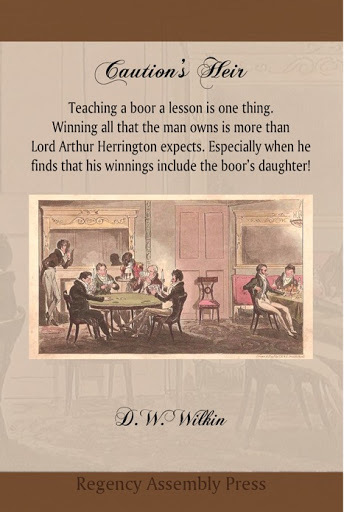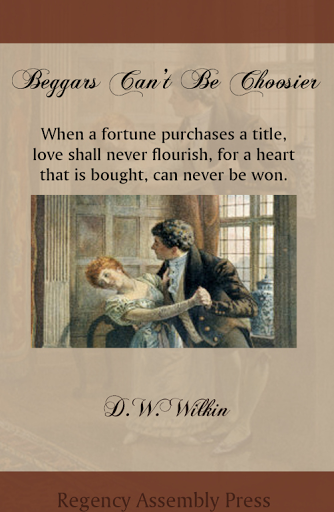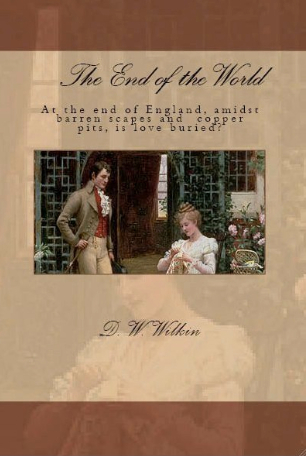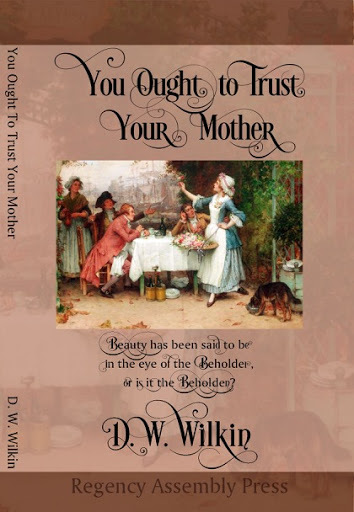D.W. Wilkin's Blog, page 26
September 21, 2016
Caution’s Heir from Regency Assembly Press-Now available everywhere!
Caution’s Heir is now available at all our internet retailers and also in physical form as well
The Trade Paperback version is now available for purchase here @ $15.99 (but as of this writing, it looks like Amazon has still discounted it 10%)
Caution’s Heir is also available digitally for $4.99 @ the iBookstore, Amazon, Barnes and Noble, Kobo and Smashwords.
The image for the cover is a Cruikshank, A Game of Whist; Tom & Jerry among the ‘Swell Broad Coves.’ Tom and Jerry was a very popular series of stories at the time.
Teaching a boor a lesson is one thing.
Winning all that the man owns is more than Lord Arthur Herrington expects. Especially when he finds that his winnings include the boor’s daughter!
The Duke of Northampshire spent fortunes in his youth. The reality of which his son, Arthur the Earl of Daventry, learns all too well when sent off to school with nothing in his pocket. Learning to fill that pocket leads him on a road to frugality and his becoming a sober man of Town. A sober but very much respected member of the Ton.
Lady Louisa Booth did not have much hope for her father, known in the country for his profligate ways. Yet when the man inherited her gallant uncle’s title and wealth, she hoped he would reform. Alas, that was not to be the case.
When she learned everything was lost, including her beloved home, she made it her purpose to ensure that Lord Arthur was not indifferent to her plight. An unmarried young woman cast adrift in society without a protector. A role that Arthur never thought to be cast as. A role he had little idea if he could rise to such occasion. Yet would Louisa find Arthur to be that one true benefactor? Would Arthur make this obligation something more? Would a game of chance lead to love?
Today, the iBookstore is added, HERE
Get for your Kindle, Here
In Trade Paperback, Here
Digitally from Smashwords, Here
For your Sony Kobo, Here
Or for your Nook, Here
From our tale:
Chapter One
St. Oswald’s church was bleak, yet beautiful all in one breath. 13th century arches that soared a tad more than twenty feet above the nave provided a sense of grandeur, permanence and gravitas. These prevailed within, while the turret-topped tower without, once visible for miles around now vied with mature trees to gain the eye of passers-by.
On sunny days stain-glass windows, paid for by a Plantagenet Baron who lived four hundred years before and now only remembered because of this gift, cast charming rainbow beams across the inner sanctum. And on grey overcast days ghostly shadows danced along the aisle.
As per the custom of parish churches the first three pews were set-aside for the gentry. On this day the second pew, behind the seat reserved for the Marquess of Hroek, who hadn’t attended since the passing of his son and heir, was Louisa Booth his niece and her companion Mrs Bottomworth.
Mrs Bottomworth was a stocky matron on the good side of fifty. Barely on the good side of fifty. But one would not say that was an unfortunate thing for she wore her years well and kept her charge free of trouble. Mrs Bottomworth’s charge was an only child, who would still have been in the schoolroom excepting the fact of the death of her mother some years earlier. This had aged the girl quickly, and made her hostess to her father’s household. The Honourable Hector Booth, third son of the previous Marquess, maintained a modest house on his income of 300 pounds. That was quite a nice sum for just the man and one daughter, with but five servants. They lived in a small, two floor house with four rooms. It should be noted that this of course left two bedchambers that were not inhabited by family members. As the Honourable Mr Booth saved his excess pounds for certain small vices that confined themselves with drink and the occasional wager on a horse, these two rooms were seldom opened.
Mrs Bottomworth had thought to make use of one of the empty rooms when she took up her position, but the Honourable Hector Booth advised and instructed her to share his daughter’s room. For the last four years this is what she had done. When two such as these shared a room, it was natural that they would either become best of friends, or resent each other entirely. Happily the former occurred as Louisa was in need of a confidant to fill the void left in her mother’s absence, and Mrs Bottomworth had a similar void as her two daughters had grown and gone on to make their own lives.
The Honourable Mr Booth took little effort in concerning himself with such matters as he was ever about his brother’s house, or ensconced in a comfortable seat at either the local tavern or the Inn. If those locations had felt he was too warm for them, he would make a circuit of what friends and acquaintances he had in the county. The Honourable Mr Booth would spend an hour or two with a neighbour discussing dogs or hunters, neither of which he could afford to keep, though he did borrow a fine mount of his brother to ride to the hunt. The Marquess took little notice, having reduced his view of the world by degrees when first his beloved younger brother who was of an age between the surviving Honourable Mr Booth had perished shortly after the Marquess’ marriage. Their brother had fallen in the tropics of a fever. Then the Marquess had lost his second child, a little girl in her infancy, his wife but a few years after, and most recently his son and heir to the wars with Napoleon.
This caused the Honourable Mr Booth to be heir to Hroek, a situation that had occurred after he had lost his own wife. With that tragedy, Mr Booth had found more time to make friends with all sorts of new bottles, though not to a degree that it was considered remarkable beyond a polite word. Mr Booth was not a drunkard. He was confronting his grief with a sociability that was acceptable in the county.
Louisa, however, was cast further adrift. No father to turn to. No uncle who had been the patriarch of the family her entire life. And certainly now no feminine examples to follow but her companion and governess, Mrs Bottomworth. That Mrs Bottomworth was an excellent choice for the task was more due to acts of the Marquess, still able to think clearly at the time she was employed, than to the Honourable Mr Booth. Mr Booth was amenable to any suggestion of his elder brother for that man controlled his purse, and as Mr Booth was consumed with grief, while the Marquess had adapted to various causes of grief prior to the final straw of his heir’s death, the Marquess of Hroek clearly saw a solution to what was a problem.
Now in her pew, where once as a young girl she had been surrounded by her cousins, parents, uncles and aunt, she sat alone except for her best of friends. Louisa was full of life in her pew, her cheeks a shade of pink that contrasted with auburn hair, which glistened as sunlight that flowed though the coloured panes of glass touched it from beneath her bonnet. Blue eyes shown over a small straight nose, her teeth were straight, though two incisors were ever so slightly bigger than one would attribute to a gallery beauty painted by Sir Thomas Lawrence.
She was four inches taller than five feet, so rather tall for a young woman, but her genes bred true, and many a girl of the aristocracy was slightly taller than those women who were of humbler origins. Her back was straight and for an observant man, of which there were some few in the county, her figure might be discussed. The wrath though of her uncle the Marquess would not wish to be bourne should it be found out that her form had become a topic amongst the young men. Noteworthy though was that she had a figure that men thought inspiring enough to tempt that wrath, and think on it. A full bosom was high on her chest, below her heart shaped face. She was lean of form, though her hips flared just enough that one could see definition in her torso. Certainly a beauty Sir Thomas’ brushes would wish the honour to meet.
The vicar Mr Spotslet had at one time in his early days in the community, discussed the Sunday sermons with the Marquess. Mr Spotslet had enjoyed long discussions of theology, philosophy, natural history and the holy writ that were then thoughtfully couched in terms to be made accessible by the parish. The lassitude that had overtaken the Marquess had caused those interviews to become shortened and infrequent and as such the sermons suffered, as many were wont to note. There had been dialogues that Mr Spotslet had engaged in with the attendees of his masses. Now he seemed to have lost his way and delivered soliloquies.
This day Mr Spotslet indulged in a speech that talked to the vices of gambling. The local sports, of which the Honourable Mr Booth was an intimate, had raced their best through the village green the previous Wednesday for but a prize of one quid, and this small bet had caused pandemonium when Mrs McCaster had fallen in the street with her washing spread everywhere and trampled by the horses. Not much further along the path, Mr Smith the grocer’s delivery for the vicar himself was dropped by the boy and turned into detritus as that too was stampeded over. A natural choice for a sermon, yet only two of the culprits were in attendance this day. The rest had managed to find reasons to avoid the Mass.
Louisa squirmed a little in her seat the moment she realised that her father had been one of the men that the sermon was speaking of. Was she not the centre of everyone’s gaze at such a time? Her father having refused to attend for some years, and her uncle unable due to his illness. She was the representative of the much reduced family. Not only was it expected that the parish would look to her as the Booth of Hroek, but with her father’s actions called to the attentions of all, it was natural that they look at her again. This time in a light that did not reflect well on her father and she knew that she had no control over that at all.
Mrs Bottomworth, who might have been lightly resting her eyes, Louisa would credit her in such a generous way, came to tensing at the mention of the incident. Louisa did not want to bring her friend to full wakefulness, but Mrs Bottomworth realised what was occurring and the direction that the sermon was taking. Louisa’s companion took her hand and patted it reassuringly.
“Perhaps a social call on Lady Walker?” Mrs Bottomworth suggested as they walked back to the house after services. The house which sat just within the estate boundaries was four hundred feet off the main bridal way that led to Hroek Castle. A small road had been cleared from the gatehouse to the house that Mr Booth now maintained, and this the two women travelled.
Louisa generally appreciated visits such as this as she had gotten older, and certainly several of the adults in the neighbourhood showed a kindly interest in her education and the development of her social manners. “I think I shall go to the castle and read to my uncle.” A task that she had done each day of the last fortnight but one.
“We have not talked, but you and the Marquess had an interview with the doctors.” Mrs Bottomworth had tried to comfort her charge after that, but Louisa had waved her hand and gone to sit quietly under a yew tree that had a grand vista of the park leading to Hroek Castle.
“Uncle will be most lucky if he should be with us come Michaelmas.”
“That will be a sad day when we lose such a friend.” These were words of comfort. Mrs Bottomworth had been well encouraged in her charge by the Marquess but one could not say that they interacted greatly with one another. The Marquess ensured that his brother heeded the suggestions and advisements of Mrs Bottomworth as the Honourable Mr Booth left to his own devices would have kept his daughter in the nursery and would have forgotten to send a governess to provide her with instruction.
“Indeed, my uncle may not have been one of the great men of England, but he is well regarded in the county.” Often with that statement followed the next, “Warmly remembered is it when the Prince Regent came and stayed for a fortnight of sport and entertainment.” This had been many years before, and certainly before any of the tragedies beset the line of the Booths.
“Yes, I have heard it said with great earnestness. But come let us change your clothes and then we shall go up to the great house. I shall have Mallow fetch the gig so we may proceed all the more expeditiously.”
“That would be good, but we will have to use the dogcart. Father was to take the gig to see Sir Mark today, or so he said at breakfast.” Where Louisa knew he would drink the Baronet’s sherry for a couple hours before thinking to return, unless he was asked to stay for dinner.


September 20, 2016
Regency Personalities Series-Martha Lloyd
Regency Personalities Series
In my attempts to provide us with the details of the Regency, today I continue with one of the many period notables.
Martha Lloyd
1765 – 24 January 1843
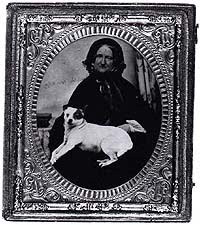
Martha Lloyd
Martha Lloyd was the eldest daughter of Rev. Noyes Lloyd of Bishopstone in (Wiltshire and his wife, Martha Craven. Her mother was second daughter of the Royal Governor of South Carolina, Charles Craven. She is believed to have met her future husband in Newbury, when she and her sister lived there with an aunt. Mrs Lloyd considered herself fortunate to have married “a beneficed clergyman of respectable character and good position.” The Lloyds settled down and had four children. Martha, the oldest daughter, was born in 1765 and her sister Mary in 1771. A few years later, a smallpox epidemic took the life of their brother and left the two older sisters scarred for life, though the youngest, Eliza, seems to have escaped relatively unharmed. When the Rev. Lloyd died in 1789, the Lloyd family lived for two or three years in the parsonage at Deane, a benefice held by Rev. George Austen. During this period, Martha Lloyd and her sister Mary became particular friends of Cassandra and Jane Austen, friendships that lasted as long as they lived.
The Lloyd family had much in common with the Austens and from an early time, visits between the two families were frequent. Though no one knows quite how they met, the Austens and Lloyds shared many mutual friends and when the Rev. Lloyd died in 1789, his widow and her two oldest, single daughters were happy to move into the unused Deane parsonage offered by Rev. Austen. Their time there, only a mile and a half from Steventon, must have been a delight for young Jane, for though she was ten years younger than the oldest Lloyd daughter, Martha, they were, as Jane’s cousin Eliza de Feuillide remarked, “very sensible and good-humored.”
Austen considered Martha to be a second sister, as her letter of 13 October 1808, written to Cassandra, shows: “With what true sympathy our feelings are shared by Martha, you need not be told;—she is the friend & Sister under every circumstance.”
Three years later, when Jane Austen’s brother, James, married and assumed the parish of Deane, it was necessary for the Lloyds to move, this time to a home in Hurstbourne, called Ibthorpe. Though only 15 miles (24 km) from Steventon, this separation must have seemed cruel to Jane, who had few friends nearby and no mode of transportation. It is clear from Jane Austen’s correspondence that her friend Martha was privy to her great secret—her writing. An early piece of Juvenilia, Frederick and Elfrida, is dedicated to her “As a small testimony of the gratitude I feel for your late generosity to me in finishing my muslin Cloak, I beg leave to offer you this little production of your sincere Friend” and later writings prove that she had been allowed to see the manuscripts for Love and Freindship [sic] and for First Impressions, an early version of Pride and Prejudice and an honor accorded to few.
In 1805 changes abounded for the Austen and Lloyd families. Many years had now passed since James Austen’s first wife had died and he had remarried again, choosing the younger Miss Mary Lloyd to be his second wife. With The Rev, George Austen’s retirement and his family’s to Bath in 1801, James had taken over both the Deane and Steventon, Hampshire holding and his growing family now lived in the Steventon parsonage.
It was while they were living in Bath, Somerset that Mr. Austen finally succumbed to his long illness and not too many months later that Mrs. Lloyd also died. The women, being in a delicate financial state, decided to combine housekeeping and all four (Mrs. Austen, Cassandra, Jane and Martha Lloyd) moved to Southampton to be with Jane’s younger brother Frank and his wife, Mary. As an officer in the Navy, Frank was often away from home and this joining of households not only helped him look after his widowed mother, but provided constant companionship for his soon pregnant wife. It seems to have been, by all accounts, an excellent arrangement.
On 7 July 1809, Jane Austen moved to a cottage in Chawton, together with her mother, her sister Cassandra, and their friend Martha Lloyd, at the invitation of her brother Edward Austen Knight, on whose estate it lay. Their new house was a late 17th Century brick building with two sitting rooms, five bedrooms, kitchens, garrets, outbuildings, and about 2 acres (8,100 m2) of grounds. It had once been an inn, and stood at the junction where the Gosport and Winchester roads met and became the main road to London.
The family remained at Chawton Cottage, even after Jane Austen’s death in 1817. Martha Lloyd took on many duties as housekeeper for the family, though the work was divided among the three surviving women. Unfortunately for Frank, by now Sir Francis Austen, his happy home was broken up upon the death of his wife in 1823 after the birth of their 11th child. In 1828 he remarried, completing the family circle by wedding Martha Lloyd. At sixty-two, Martha was at last a bride, and more than that, Lady Austen.
Martha Lloyd’s role as Jane Austen’s friend and confidante cannot be overvalued and her contribution to what we know of Austen’s life is significant. We have not only letters written by Jane to Martha, but Martha’s collection of recipes used at Chawton, which were later compiled into A Jane Austen Household Book by Peggy Hickman, David & Charles, Ltd. 1977, and in The Jane Austen Cookbook by Maggie Black and Deirdre Le Faye, British Museum Press, 1995 (ISBN 0-7141-2769-8). Martha Lloyd is also directly mentioned in Jane Austen’s poem, Oh! Mr. Best You’re Very Bad.
A single photograph (daguerreotype) exists of Martha, capturing her in old age accompanied by her dog. It must have been taken at some point after 1839 (when the daguerreotype was invented).
Martha Lloyd died in 1843.


RAP’s has Beggars Can’t Be Choosier
One of the our most recent Regency Romances.
Beggars has won the prestigious Romance Reviews Magazine Award for Outstanding Historical Romance:
It has also been nominated for the 2015 RONE Awards in the category of Historical:Post Medieval sponsored by InD’Tale Magazine.

It is available for sale and I hope that you will take the opportunity to order your copy.
For yourself or as a gift. It is now available in a variety of formats. For $3.99 you can get this Regency Romance for your eReader. A little more as an actual physical book.
When a fortune purchases a title, love shall never flourish, for a heart that is bought, can never be won.
The Earl of Aftlake has struggled since coming into his inheritance. Terrible decisions by his father has left him with an income of only 100 pounds a year. For a Peer, living on such a sum is near impossible. Into his life comes the charming and beautiful Katherine Chandler. She has a fortune her father made in the India trade.
Together, a title and a fortune can be a thing that can achieve great things for all of England. Together the two can start a family and restore the Aftlake fortunes. Together they form an alliance.
But a partnership of this nature is not one of love. And terms of the partnership will allow both to one day seek a love that they both deserve for all that they do. But will Brian Forbes Pangentier find the loves he desires or the love he deserves?
And Katherine, now Countess Aftlake, will she learn to appreciate the difference between happiness and wealth? Can love and the admiration of the TON combine or are the two mutually exclusive?
Purchase here:Amazon Kindle, Barnes and Noble Nook, Kobo, Smashwords, iBooks, & Trade Paperback
Feedback
If you have any commentary, thoughts, ideas about the book (especially if you buy it, read it and like it
September 19, 2016
Regency Personalities Series-Morton Eden 1st Baron Henley
Regency Personalities Series
In my attempts to provide us with the details of the Regency, today I continue with one of the many period notables.
Morton Eden 1st Baron Henley
8 July 1752 – 6 December 1830
Morton Eden 1st Baron Henley was a British diplomat.
Eden was a younger son of Sir Robert Eden, 3rd Baronet and was educated at Eton and Christ Church, Oxford. From 1776–79, he was Minister to Bavaria, then to Copenhagen 1779–82, Dresden 1783–91, Berlin 1791–93 and Vienna 1793–94. From 1794–95, he was Ambassador to Spain and returned as Minister to Vienna in 1794 until 1799. He then retired with a pension of £2000
In 1799, Eden was created Baron Henley, after having been knighted in 1791 and admitted to the Privy Council in 1794. On 7 August 1783, he had married Lady Elizabeth Henley (the youngest daughter of the 1st Earl of Northington) and they had four children. Lord Henley died in 1830 and was succeeded by his eldest surviving son, Robert.


Conclusion of the Trolling Series-We’ll All Go A Trolling
We’ll All Go A Trolling Not only do I write Regency and Romance, but I also have delved into Fantasy.
The Trolling series is the story of a man, Humphrey. We meet him as he has left youth and become a man with a man’s responsibilities.
We follow him in a series of stories that encompass the stages of life. We see him when he starts his family, when he has older sons and the father son dynamic is tested.
We see him when his children begin to marry and have children, and at the end of his life when those he has loved, and those who were his friends proceed him over the threshold into death.
All this while he serves a kingdom troubled by monsters. Troubles that he and his friends will learn to deal with and rectify. It is now available in a variety of formats.
For $2.99 you can get this fantasy adventure.
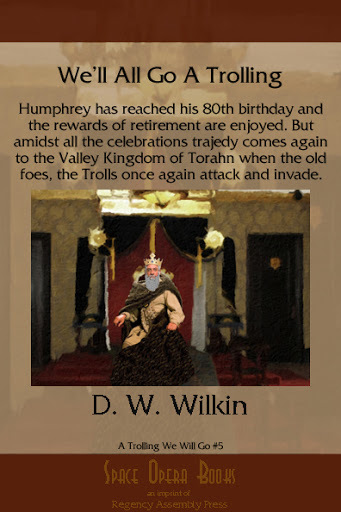
Barnes and Noble for your Nook
King Humphrey, retired, has his 80th birthday approaching. An event that he is not looking forward to.
A milestone, of course, but he has found traveling to Torc, the capital of the Valley Kingdom of Torahn, a trial. He enjoys his life in the country, far enough from the center of power where his son Daniel now is King and rules.
Peaceful days sitting on the porch. Reading, writing, passing the time with his guardsmen, his wife, and the visits of his grandson who has moved into a manor very near.
Why go to Torc where he was to be honored, but would certainly have a fight with his son, the current king. The two were just never going to see eye to eye, and Humphrey, at the age of 80, was no longer so concerned with all that happened to others.
He was waiting for his audience with the Gods where all his friends had preceded him. It would be his time soon enough.
Yet, the kingdom wanted him to attend the celebrations, and there were to be many. So many feasts and fireworks he could not keep track, but the most important came at the end, when word was brought that the Trolls were attacking once more.
Now Humphrey would sit as regent for his son, who went off to fight the ancient enemy. Humphrey had ruled the kingdom before, so it should not have been overwhelming, but at eighty, even the little things could prove troublesome.
Feedback
If you have any commentary, thoughts, ideas about the book (especially if you buy it, read it and like it
September 18, 2016
Regency Personalities Series-Alexander Nasmyth
Regency Personalities Series
In my attempts to provide us with the details of the Regency, today I continue with one of the many period notables.
Alexander Nasmyth
9 September 1758 – 10 April 1840
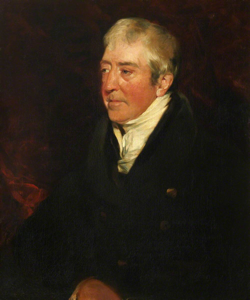
Alexander Nasmyth
Alexander Nasmyth was born in Edinburgh on 9 September 1758. He studied at the Royal High School and the Trustees’ Academy and was apprenticed to a coachbuilder. Aged sixteen, he was taken to London by portrait painter Allan Ramsay where he worked on subordinate parts of Ramsay’s works. Nasmyth returned to Edinburgh in 1778, where he worked as a portrait painter. Offered a loan by Patrick Miller of Dalswinton, Nasmyth left in 1782 for Italy, where he remained two years furthering his studies. In Italy he devoted most of his attention to landscape painting, and is recorded as having copied a work by Claude.
Nasmyth returned to Scotland where for the next few years he continued his career as a portraitist. He painted some works in the style of Ramsay, but most were conversation pieces with outdoor settings. His portrait of Robert Burns, who became a close friend, is now in the Scottish National Gallery. Eventually, Nasmyth’s strong Liberal opinions offended many of his aristocratic patrons in a politically charged Edinburgh, leading to a falling off in commissions for portraits, and in 1792 he completely abandoned the genre, turning instead to landscape painting. He also began painting scenery for theatres, an activity he continued for the next thirty years, and in 1796 painted a panorama.
His landscapes are all of actual places, and architecture is usually an important element. Some works were painted to illustrate the effects that new buildings would have on an area, such as Inverary from the Sea, painted for the Duke of Argyll to show the setting a proposed lighthouse.
Nasmith had a great interest in engineering, and proposed several ideas that were later widely used, although he never patented any of them. In October 1788, when Patrick Miller sailed the world’s first successful steamship, designed by William Symington, on Dalswinton Loch, Nasmyth was one of the crew.
He was employed by members of the Scottish nobility in the improvement and beautification of their estates. He designed the circular temple covering St Bernard’s Well by the Water of Leith (1789), and bridges at Almondell, West Lothian, and Tongland, Kirkcudbrightshire. In 1815 he was one of those invited to submit proposals for the expansion of Edinburgh New Town.
Nasmyth set up a drawing school and “instilled a whole generation with the importance of drawing as a tool of empirical investigation”; his pupils included David Wilkie, David Roberts, Clarkson Stanfield and John Thomson of Duddingston; and it was probably from him that John James Ruskin (father of John Ruskin) learned to paint as a schoolboy in Edinburgh in the later 1790s. Another successful pupil was the painter, teacher, art dealer and connoisseur Andrew Wilson, who had his first art training under Nasmyth.
Nasmyth died at home, 47 York Place (roughly opposite the house of Sir Henry Raeburn) in Edinburgh. He was buried in St Cuthbert’s Churchyard at the west end of Princes Street.
Nasmyth’s six daughters all became artists. His eldest son, Patrick Nasmyth, studied under his father, then went to London and attracted attention as a landscapist. Another son, James Nasmyth, invented the steam hammer.


RAP (Regency Assembly Press) in need of Beta-Readers
Regency Assembly
Press
is looking for
Beta Readers
One novel is ready for Beta Reading
We have a continuation of Pride and Prejudice with Ms Caroline Bingley and her fortune at stake:
Do we think that Mr Hurst married his Bingley Bride without incentive? It is highly probable that Caroline Bingley, even though she has a sharp, acerbic tongue, still is in possession of a fortune and an astute fortune hunter who deciphers this may soon be on the road to, if not a happy marriage, one with financial security.
Please respond or send an email if you are interested


RAP has The End of the World
The End of the World This is the first of the Regency Romances I published. It is available for sale and I hope that you will take the opportunity to order your copy.
For yourself or as a gift. It is now available in a variety of formats. And now at the reduced price of $3.99 you can get this Regency Romance for your eReader. A little more as an actual physical book.
Barnes and Noble for your Nook
Amazon for your Kindle and as a Trade Paperback
Hermione Merwyn leads a pleasant, quiet life with her father, in the farthest corner of England. All is as it should be, though change is sure to come. For she and her sister have reached the age of marriage, but that can be no great adventure when life at home has already been so bountiful.
When Samuel Lynchhammer arrives in Cornwall, having journeyed the width of the country, he is down to his last few quid and needs to find work for his keep. Spurned by the most successful mine owner in the county, Gavin Tadcaster, Samuel finds work for Gavin’s adversary, Sir Lawrence Merwyn.
Can working for Sir Lawrence, the father of two young women on the cusp of their first season to far away London, be what Samuel needs to help him resolve the reasons for his running away from his obligations in the east of the country?
Will the daughters be able to find happiness in the desolate landscapes and deadly mines of their home? When a stranger arrives in Cornwall while the war rages on the Peninsula, is he the answer to one’s prayers, or a nightmare wearing the disguise of a gentleman?
Feedback
If you have any commentary, thoughts, ideas about the book (especially if you buy it, read it and like it
September 17, 2016
Regency Personalities Series-George Howard 7th Earl of Carlisle
Regency Personalities Series
In my attempts to provide us with the details of the Regency, today I continue with one of the many period notables.
George Howard 7th Earl of Carlisle
18 April 1802 – 5 December 1864
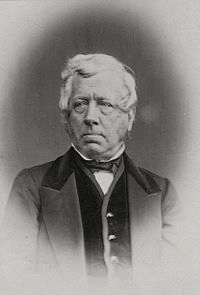
George Howard
George Howard 7th Earl of Carlisle was born in Westminster, London, the eldest son of George Howard, 6th Earl of Carlisle by his wife Lady Georgiana Cavendish, eldest daughter of William Cavendish, 5th Duke of Devonshire. Lord Lanerton and Charles Howard were his younger brothers. He was educated at Eton and Christ Church, Oxford, where he earned a reputation as a scholar and writer of graceful verse, obtaining in 1821 both the chancellor’s and the Newdigate prizes for a Latin poem, Paestum, and an English one. He maintained his interest in poetry throughout his life, exchanging sonnets with William Wordsworth. In 1826 he accompanied his maternal grandfather, the Duke of Devonshire, to the Russian Empire, to attend the coronation of Tsar Nicholas I, and became a great favourite in society at St Petersburg.
At the general election in 1826 Carlisle was returned to parliament as member for the family borough of Morpeth (in Northumberland), a seat he held until 1830, and then represented Yorkshire until 1832 and the West Riding of Yorkshire from 1832 to 1841 and from 1846 to 1848. The latter year he succeeded his father in the earldom and entered the House of Lords.
Carlisle served under Lord Melbourne as Chief Secretary for Ireland between 1835 and 1841, under Lord John Russell as First Commissioner of Woods and Forests from 1846 to 1850 and as Chancellor of the Duchy of Lancaster from 1850 to 1852 and under Lord Palmerston as Lord Lieutenant of Ireland from 1855 to 1858 and again from 1859 to 1864. In 1835 he was appointed to the Privy Councils of the United Kingdom and Ireland. On 2 April 1853, he was given the Freedom of the City of Edinburgh, and in 1855, he was made a Knight of the Garter.
Lord Carlisle died unmarried at Castle Howard in December 1864, aged 62, and was buried in the family mausoleum. He was succeeded in the earldom by his younger brother, Reverend William George Howard.


You Ought to Trust Your Mother (YOTTYM) now released
Now available the next Regency Romance tale by D.W. Wilkin:
Beauty has been said to be in the eye of the Beholder, or is it the Beholden.
The tale of Baron Fallion Lancelot Stafford, a gentleman of perhaps too much leisure who has served in the wars of some few years before. He now has decided that all this leisure is perhaps a waste and he should be doing something. He was just very unsure what that was.
We also find Lady Beatrice Cavendish, the daughter of the Earl of Hoare who is famed for her beauty, yet cannot find any man who has more to speak to her beyond that one subject. And yet far too many think they should offer for her with only the ardent praise to her looks to recommend them. Perhaps there exists one suitor who could speak on a subject beyond that?
In the rush of the Season of 1821, where their most intimate friends have all come to the conclusion that they should marry, can Beatrice put aside her willful ways and hear sound thoughts that her mama has said on that particular subject? Beatrice was sure that her mother would be content if she accepted the Baron Tweedglen, or any of a dozen other men of good breeding, position, or wealth. Whether they had ought to speak on her attractiveness, and no other words would leave their mouths.
Certainly a marriage with such foundations was doomed to crumble once age advanced and liver spots or wrinkles appeared. Yet amongst the Ton, such marriages were often deemed successes. Would they be so for Beatrice, though? That was something she was destined to apply her own thoughts to.
For Baron Tweedglen, the haunting memory of the war caused him to avoid any reference to his time spent prosecuting that undertaking. Such deamons as consumed his psyche, were magnified as his desire was for a world that art flourished and certainly his experience had been the exact opposite of such an inclination. The Baron was desperately in need of something that could save him from his own self. Was there a remedy in marriage as the entire Ton seemed to believe?
Now available on Amazon for $15.99…
also available for your Kindle and Kindle Reading Apps for $3.99
for those who have iPads, Nooks, or other devices, the book is also available at:
The Apple iBookstore, Barnes and Noble Nook store, Kobo, and Smashwords for $3.99 as well.



